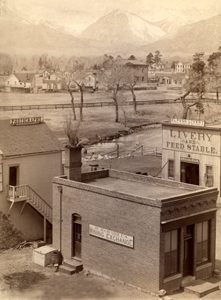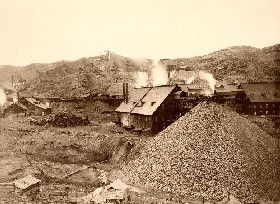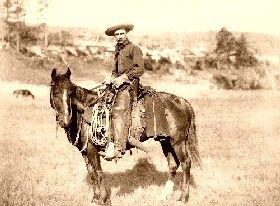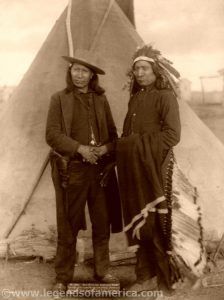John C. H. Grabill – Photographing the West – Legends of America (original) (raw)
Miners Exchange Building and Photography Studio in Buena Vista, Colorado by John Grabill, 1886.
John C. H. Grabill was an American photographer known for his photographs taken in South Dakota and Wyoming in the late 19th century.
Grabill was born in 1849 in Donnelsville, Ohio, to David and Catherine Kees Grabill. By 1860, the family moved to Champaign, Illinois. In 1868, his parents divorced, and he moved to Chicago with his mother and siblings, where she ran a boarding house for several years.
In about 1879, he went to Colorado to join the gold rush. He first worked around Leadville before going to Pitkin and Chaffee Counties. Working with a mining partner named Nelson Wanamaker, the pair were known to have located three contiguous mining claims at Mount Blanco, Mount Crystal, and Mount Antero, the first site discovery of Aquamarine, Colorado’s official gemstone. In 1882, a Buena Vista Map shows that he was operating an assay office out of a building called the “Mining Exchange Office.” He also partnered with H. McCall in the Mammouth and Vallejo mines on Aspen Mountain.
On October 3, 1885, Grabill married Margaret “Maggie” Gillespie, a teacher who was also formerly of Illinois. He had also been learning and practicing photography skills somewhere along the line because, on December 16, 1885, the Buena Vista Democrat reported: “J.C.H. Grabill will soon be prepared to do business in the photograph line.” By January 1886, he had opened for business, and the newspaper noted on March 24, 1886: “J.C.H. Grabill is producing some of the finest photographs ever seen in this country.”
Homestake Mine, South Dakota, by John Grabill, 1889.
By September 1886, John and Maggie headed northeast toward the Black Hills Goldrush. They settled in Sturgis, South Dakota, in November 1886 and opened a photographic studio. On February 7, Maggie gave birth to their only son, Ralph Gillespie Grabill. By 1888, they had moved to Deadwood, South Dakota; in 1890, he had a second studio in nearby Lead. Grabill was appointed as the Homestake Mining Company’s official photographer in 1890 and later was appointed as the official photographer of the Black Hills and Fort Pierre Railroad. In October 1890, Grabill traveled to Devil’s Tower to get signatures on a petition to create a Devil’s Tower National Monument. This was presented to the President, Congress, and Secretary of the Interior.
By 1991, Grabill had financial difficulties, and the local newspaper announced that the Grabill Photograph and View Company had filed for bankruptcy. The next year, John’s wife, Maggie, divorced him and left with their son. He never saw them again.
Between 1887 and 1892, he sent 188 photographs of railroads, mining, Native Americans, and settlers’ lives in the region to the Library of Congress for copyright protection.
The Cow Boy, circa 1887, by John C. H. Grabill, Sturgis, Dakota Territory.
By the time the World’s Columbian Exposition was held in Chicago in 1893, Grabill had returned east and taken photographs during this event. He also opened the “Grabill Chicago Portrait and View Co.”
Grabill lived In St. Louis, Missouri, between 1901 and 1903, where he worked as a salesman for Fairbanks, Morse, and Company, who manufactured, among other things. The mining industry used these hydraulic pumps. However, his mental health had deteriorated, causing him to be institutionalized in February 1903 at the St. Louis City Insane Asylum. He died there on August 23, 1903of death, of paralytic dementia. He was buried at St. Matthew’s Cemetery in St. Louis.
Grabill’s remarkably well-crafted, sepia-toned images captured the forces of western settlement in South Dakota and Wyoming, leaving a visual record of railroad development, stagecoaches and wagons, mining, smelting and milling, freighting, emerging cities and towns, cattle roundups and branding, sheepherding, prospecting, hunting, and Chinese immigrants, as well as landscapes. A number of the images portray the Lakota Sioux living on or near the Cheyenne River and the Pine Ridge Reservation and their contact with U.S. military and government agents, as well as with William “Buffalo Bill” Cody. Some of the photographs were taken only days after the 1890 massacre at Wounded Knee near Pine Ridge.
Compiled by Kathy Alexander/Legends of America, updated April 2024.
Sioux Chiefs Red Cloud and American Horse, John C.H. Grabill, 1891.
Also See:
Artist, Photographer, & Publisher Photo Galleries
Historic Photographers of America’s History
John C.H. Grabill Photo Gallery
Sources:



